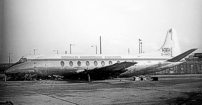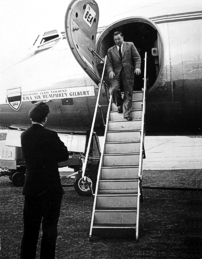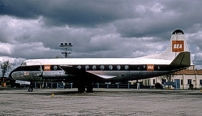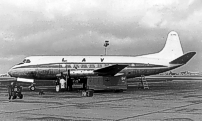
November 1953 to April 1963
British European Airways Corporation (BEA)
G-AMOK - c/n 24 - a V.701 series Viscount
United Kingdom registered
9 November 1953
Registered to British European Airways Corporation (BEA), Keyline House, Ruislip, Middlesex.
12 November 1953
Engine ground running commenced.
21 November 1953
First flight from Brooklands Airfield, Weybridge, Surrey, England.
It landed at Wisley Airfield, Surrey, England for fitting out and test flying.
8 December 1953
Certificate of Airworthiness (CofA) issued.
22 December 1953
Delivered to British European Airways (BEA) named as 'R M A Sir Humphrey Gilbert'.
It was fitted with Rolls-Royce Dart RDa3 Mark 505 engines.
The cabin was fitted out with a 47 seat all-tourist class layout.

Badly damaged at
London Airport
1954 to 1962
The original ‘cutlass’ design propeller blades were gradually replaced by new symmetrical ‘needle’ blade propeller sets.
From photographic evidence, both propeller types were fitted to Rolls-Royce Dart RDa3, Mark 505 and Mark 506 engines and many aircraft flew with an ‘intermix’ of both types of propeller blades.
16 January 1955
Crashed during a takeoff from London Airport (Heathrow), Middlesex, England while departing to Ciampino Airport, Rome, Italy, Ellinikon Airport, Athens, Greece and Yeşilköy Airport, Istanbul, Turkey.
The flight crew accidentally turned onto disused runway 03 instead of runway 15R in poor visibility.
During the takeoff run it collided with a barrier of steel girders and a Taylor Woodrow workmen's hut which tore off the port engines. Both main undercarriage assemblies punched their way through the wing upper skin.
The Captain and one passenger were injured.
Luckily it was a Sunday or there would have probably been contract workers in the area otherwise.
Of the original passengers, 22 out of 25 continued on a later replacement flight.
The Captain was blamed for the accident in the ensuing court case.

Fitted with experimental
integral front airsteps
The damaged airframe was moved to a maintenance area, still lying on its belly and with the BEA titles painted out.
It was later transported to Marshalls at Teversham Airport, Cambridge, England for major repairs.
May 1955 to December 1956
All BEA Type 701 aircraft were gradually retrofitted with Rolls-Royce Dart RDa3 Mark 506 engines which were upgraded using modified Mark 505 engines.
Aircraft are known to have flown with an ‘intermix’ of both engine marks between these dates.
When completely retro-fitted with Mark 506 engines, the Type 701A designation was applied to these aircraft although this has not been seen widely used or quoted.
September 1956
Returned to service after major repairs by Marshall's.
October 1958
Converted by Marshall's at Teversham Airport, Cambridge, England to Type 701X standard with a two flight crew operation and a 60/63 seat high density configuration which involved the fitment of an additional cabin window on each side. There was a small window on the port side and a standard size window on the starboard side. This was the first BEA Viscount to be converted.
March 1959
A new BEA 'Red Square' livery was adopted and aircraft were repainted during the early 1960s when they next went in for overhaul. This took some of the fleet into the early 1960s before this was accomplished.
Sadly, after repainting, the aircraft no longer carried a name including the nameplate on the forward cabin bulkhead.

BEA
‘Red Square‘ livery
31 March 1959
BEA annual report quotes a total time of 4,712 hours.
May 1959
Fitted with experimental integral front 'airsteps' by Marshall's of Teversham Airport, Cambridge, England but this was not adopted across the fleet.
15 December 1959
Noted at Blackbushe Airport, Hampshire, England due to a London Airport weather diversion.
1959
Converted from 40/47 seats to 60/63 seats in a new high density configuration. This modification also entailed the installation of an 11th standard size window on the rear starboard side and a small window behind the rear entrance door on the port side.

Rolled out at Heathrow,
London, England as G-AMOK
29 March 1963
Rolled out from the BEA facility at London Airport (Heathrow), Middlesex, England in full LAV livery with the UK registration at the top of the tail.
1 April 1963
Sold to Linea Aeropostal Venezolana (LAV).
 FURTHER READING: Books about BEA - British European Airways FURTHER READING: Books about BEA - British European Airways
|



